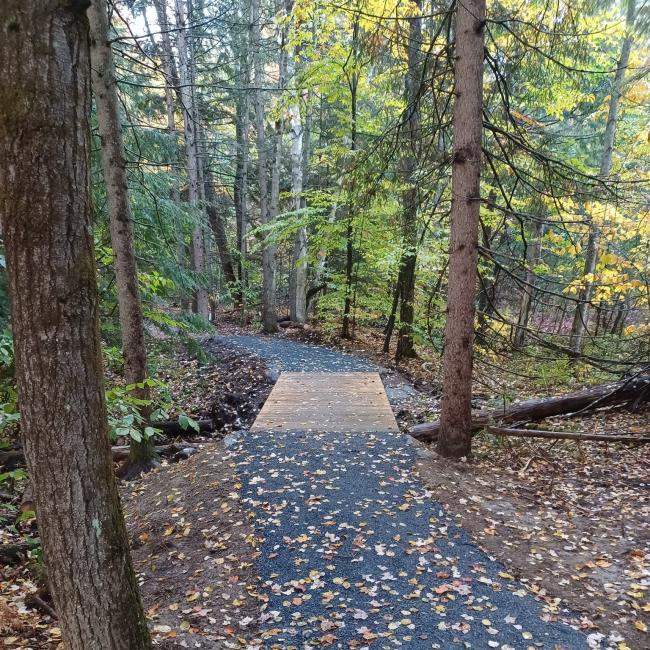April 22, 2024

When my mother was in a wheelchair, I was acutely aware of all the parks and green places she could not access. Over the last two years, due to a health condition, my own ability to move outdoors has drastically changed. I’ve been thinking a lot about how most of us, whether we think of ourselves as disabled or not, lose some of our abilities over time.
According to the Center for Disease Control and Prevention, 1 in 4 adults in the United State have some kind of disability. This might mean we were born with a condition that limits our physical abilities, or we develop Parkinson’s disease as my mother did, have an accident and become wheelchair bound, or maybe we just lose our hearing or springy knees as we age.
What is happening in Vermont to make trees and green spaces more accessible for people with physical limitations? The Vermont Urban & Community Forestry Program’s own Urban Forester, Adam McCullough, had firsthand experience creating a universally accessible path in Montpelier’s Hubbard Park in his former position as City Arborist. While there was some initial resistance to the tree removal necessary to build the path, the contractor’s design and workflow produced a sophisticated and highly visible project that met the City’s vision of more accessible infrastructure for all bodies. I interviewed Adam to get the inside scoop on one community’s experience creating a universally accessible trail in a public forest.
I think my biggest takeaway is you have to break a few eggs to make an omelet. There's so much work that went into building the accessible trail, [But] going forward it is going to need quite a bit less maintenance than all the other trails in the park because it's just so much better designed. It has a hard packed surface that's crowned for drainage and it is far less vulnerable to stormwater due to its gentle slope. But to achieve that design meant there were excavators waltzing through the woods and there were lots of trees taken down. But you can't see that now – it looks like the path was there forever. It was definitely worth the investment of resources, time, and tree removals. This accessible trail is for everyone. It is now one of the most popular trails in Hubbard Park. It isn’t set aside for just a slim percentage of the population. It isn’t just an accessible trail, its an objectively great trail.
Adam also stated that when engaged in such a transformative, and controversial project, it was helpful for the Park staff to “Keep focusing on that message of the reason behind it, why you're doing it.” When I asked him what their “why” was he said: “Because this type of trail is going to open up experiences for so many people who couldn't necessarily have experiences in as many places outside in the woods. It's just such an important aspect of being alive - having access to nature and being outside and that anyone who wants to seek that out should have places to do it, just as a human right.
By creating trails that are accessible for strollers, wheelchairs, and other mobility aids, we begin to have outdoor spaces that are welcoming to all. Thoughtfully including facilities such as accessible parking, restrooms, and picnic areas, and incorporating sensory elements such as signage in braille and audio guides, further access to trees and forests.
Access to trees and forests is a fundamental human right that should be enjoyed by everyone, regardless of physical abilities. Tell us what you are thinking about access to public trees and forests in your community – we would love to hear your feedback!
Written by Ginger Nickerson, VT UCF's Forest Pest Education Coordinator
Photo Credit: Montpelier Parks Department
Resources on Universal Accessibility to Trees and Green Spaces in Vermont and Elsewhere
- Universally Accessible Playgrounds: Oakledge for All- The website and story of how a group of parents and concerned community members created a universally accessible playground for children with disabilities and neurological differences.
- Access Granted: Closing the Accessibility Gap in Centennial Woods
- Green Mountain Club’s list of Accessible Trails in Vermont
- National Environmental Educators Association article: Access for all on public lands
- What We’ve Learned (So Far), The Nature Conservancy